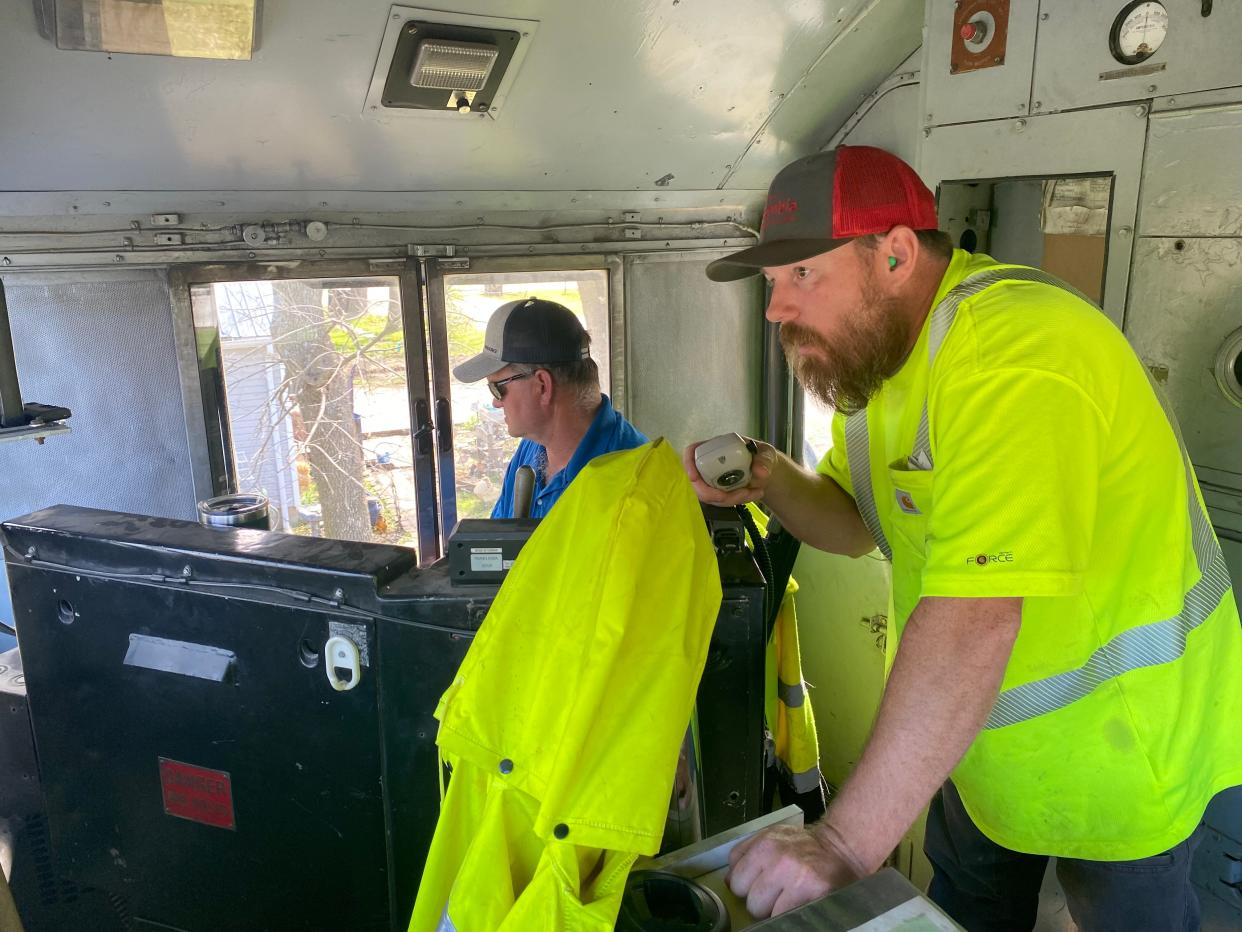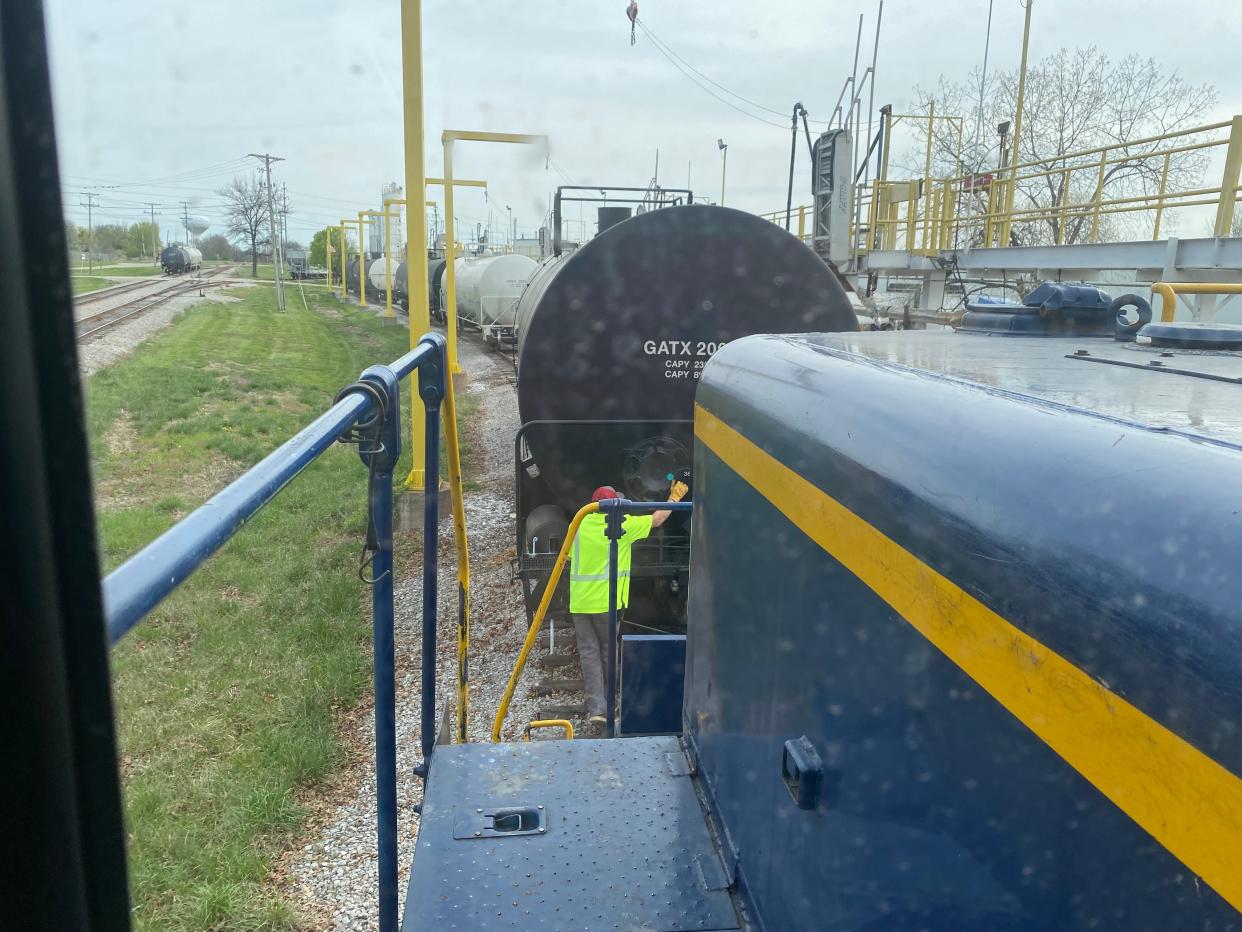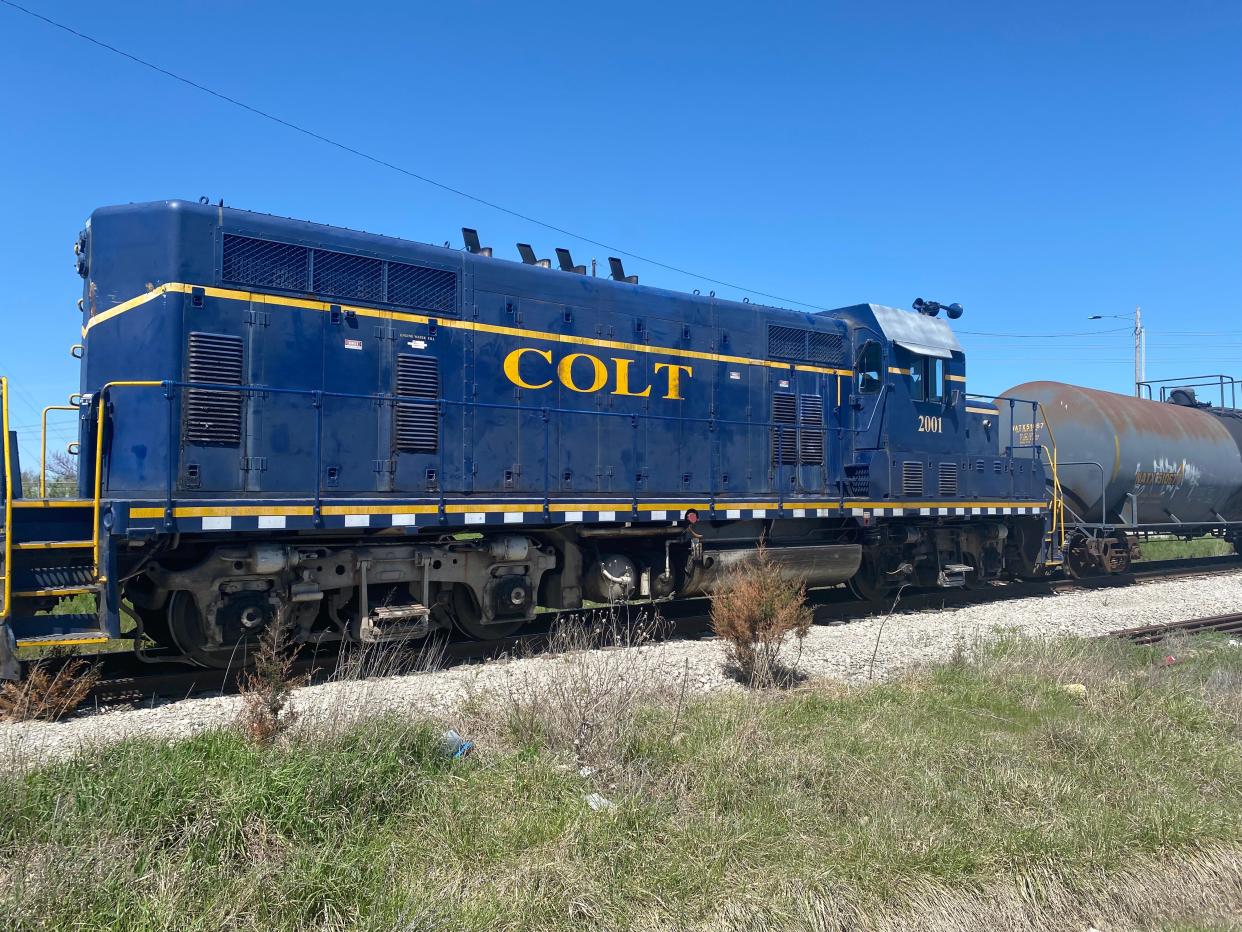Columbia Terminal Railroad is a little-known city-owned asset. Here's what it does

The two-man crew of the Columbia Terminal Railroad on April 9 transported rail cars containing lumber, coiled steel, PVC resin and a wax-based lubricant.
On this day the crew was Shane Riley, railroad operational manager, and railroad worker James Day. Another worker is Matthew Sabath. Tina Worley works part-time as a consultant for the railroad.
Each railroad car can carry as much as four semitrailers, Riley said.
Riley was driving the locomotive and Day was the train's conductor.
The locomotives operate two to three days a week, depending on customer demand, Riley said.
They travel to Mid-City Lumber to pick up its shipment.
Zach Sandner, the lumber buyer for Mid-City, said the company fills 75 to 80 railroad cars a year for the railroad, also called COLT.
"We save on our freight costs and pass it along to our customers," Sandner said.
The railroad is vital to the lumberyard's operation, he said. It employs 80 to 85 people in Columbia.
"They're super-great to work with," he said.
The railroad crew picked up one car at Mid-City and would bring two back from Centralia in the afternoon.
For large railroads, customers are names and numbers on pieces of paper, Day said.
"We know all our customers real good," Day said. "We're on a first name basis."
Before heading to Centralia, the locomotive attached more cars at the Columbia terminal on North Brown Station Road.
"It's like parking 10 cars in a driveway," Riley said. "All the others have to move to get that tenth one out."
Riley was in radio contact with Day.
"You can't see anything" in the locomotive cabin, Riley said. "You just go by what he's saying."
After much maneuvering, Day calls on the radio "all out."
"Basically he was telling me he was ready for me to take them all out of the siding," Riley said.
He said he could tell by the feel of the train that the hand brake on one of the rail cars was still activated.
"It's hard to train that, because it's all feel," Riley said.
It took him a little time to develop it, he said.
"Everything on the railroad is big and bulky," Riley said. "It doesn't forgive."
Now that he knows all about trains, he's also trying to get a pilot's license to fly planes, he said.
The railroad's two locomotives were produced in 1953 and 1954, Riley said.
"It's been rebuilt probably a few times over the years," he said of the one making the haul.
Neither Riley or Day grew up loving trains, they said. Day said he became interested in them watching them come through his hometown of Centralia, wondering where the trains were coming from and their destinations.
"I just started to think, 'I should get into that,'" Day said.
The lifestyle is one he enjoys, he said.
"It's interesting work that not everyone can do," Day said.
For Riley, it has been a job, he said.
"I've made my living and raised my family on the railroad," Riley said.
Matthew Sabath has been with the railroad since 2003. In Marty Paten's book "The Columbia Branch Railroad," Sabath recounted the night in 2005 when a pickup slammed into the side of the train at a crossing. The driver, the only person in the pickup, survived.
At Centralia, Day radioed a Norfolk Southern dispatcher in Atlanta for permission to use its rails.
A Norfolk Southern crew member had left the cars neatly lined up for the Columbia crew. It helps him by getting them out of the way, they said.
On the way back from Centralia, the locomotive reached a top speed of 26 mph going full throttle with 1,100 tons of train cars pushing it.

The railroad's past
The Columbia Branch Railroad began passenger service, mail delivery and freight service along the 21.7-mile railroad to Centralia on Oct. 29, 1867.
It originated with the Boone County and Jefferson City Railroad Company in 1857, according to "The Columbia Branch Railroad."
Development of the railroad was promoted heavily by James Sidney Rollins, a founder of the University of Missouri, according to the CoMO 365 Blog. Centralia and Sturgeon were founded as stations.
The Centralia Massacre was the most notable event along the railroad during the Civil War and happened Sept. 27, 1864.
Rollins, a U.S. congressman, owner of slaves and unionist supporter of President Abraham Lincoln, was on a stagecoach arriving in Centralia from Columbia that had been overtaken by Confederate bushwhackers. His life was in danger if discovered, but the bushwhackers were distracted by the arrival of the train into town.
Its passengers were men, women and children and 23 unarmed Union soldiers. Led by Bloody Bill Anderson, the bushwhackers ordered the Union soldiers to strip naked and line up along the track. The Union soldiers were shot and killed, covering the tracks with blood.
What followed was the deaths of 108 Union soldiers who confronted Anderson and his men during the Battle of Centralia.
Starting in 1910, the Wabash Station served the railroad. Now it is the hub for public transportation in the city, but not a railroad stop. The city celebrated its 100th anniversary in 2010.
The first diesel locomotive began operating on the Columbia branch in January 1944.
President Harry Truman traveled by train to Columbia in 1950. Passenger service ended on the railroad in 1969.
The city bought the railroad from Norfolk Southern in 1987 for $325,000 and received a $500,000 federal grant for track improvements. Columbia Terminal Railroad began operation on Oct. 6, 1987. It hauled its 10,000th carload of freight to Mid-City Lumber in April 1998.
A dinner train made a brief run on the railroad starting in 2010.

The railroad's future
Few are aware of this city-owned asset that falls under the purview of the city utilities department.
"Owned an operated by the city of Columbia since 1987, COLT serves as a crucial artery connecting businesses in Boone County with the national railroad infrastructure," reads the executive summary of an economic impact analysis by University of Missouri Extension.
"COLT has served traditional businesses along the Route B corridor for decades with several reliant upon its core operations," the report reads.
The railroad's board met on March 29 to brainstorm ways to increase the railroad's visibility and thereby increase the potential number of customers.
"The basic citizenry of Columbia don't know we own a railroad," said board member Blair Hendrickson. "The next question is why do we own a railroad?"
A blurb in the newsletter that comes with utility bills, a railroad open house, assisting scouts with their railroad merit badges and an annual railroad day were some of the ideas tossed around.
"Let's don't look at this railroad as an enterprise," said board chairman John Wilke. "Let's look at it as infrastructure that drives economic impact."
The Columbia Terminal Railroad also includes Colt Transload, which began in 2004. The warehouse at the terminal provides an intersection for converting truck transportation to train transportation.
The railroad was awarded a $328,260 Freight Enhancement Grant by the Missouri Department of Transportation in 2023 to improve infrastructure.
JM Eagle is another railroad customer. Its plant manager is Stephen Pollock.
The plant produces PVC resin, a raw material for pipes, culverts and other items, Pollock said.
During full production, the plant uses eight rail cars a month, Pollock said.
The plant employs between 45 and 60 workers.
"It's our most economical way to get our main raw material to the factories," Pollock said.
The railroad crew said Honeywell makes the wax-based lubricant that was in the tanker cars, but a corporate spokesman declined to provide information about the Columbia plant or its employment level.
The economic impact study mentioned the possibility of a company building a new rail siding and building to increase capacity, costing $50 million over five years.
There are opportunities for economic development, Worley said in a phone interview, including Park Lane, a 30-acre parcel of land along the railroad line.
"COLT's future should not be underestimated," Worley said.
Boone County Commissioner Janet Thompson is a fan.
The University of Missouri when it was established wouldn't have been in Columbia without the railroad, Thompson said.
"To me, Boone County became what it is by the grace of God and a railroad line," Thompson said. "Those founding folks realized Boone County was going to be left behind if we didn't have a railroad connection."
It's still important, she said.
"It's just a smart way to move freight," Thompson said. "It's a safe mode of transportation and it gets the job done."
Keeping the railroad strong is required, said board member Marty Oetting.
"There are potential opportunities in the future that will hinge on having a connection to that railroad network," Oetting said.
Roger McKinney is the Tribune's education reporter. You can reach him at rmckinney@columbiatribune.com or 573-815-1719.
This article originally appeared on Columbia Daily Tribune: Columbia Terminal Railroad may be small, but it's an economic asset
